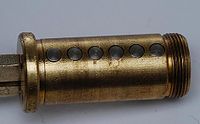Shear line: Difference between revisions
mNo edit summary |
mNo edit summary |
||
| (6 intermediate revisions by the same user not shown) | |||
| Line 1: | Line 1: | ||
=Shear Line= | =Shear Line= | ||
[[File:Schlage_Everest_pins_aligned.jpg|thumb|right|text-top|200px|A [[plug]] with the [[pin-tumbler]]s properly aligned at the shear line.]] | |||
In [[ | The '''shear line''' is the physical point at which the [[plug]] meets the [[cylinder]] inside a cylinder-based [[lock]]. This point is where components must be properly aligned to allow the plug to rotate and lock or unlock the lock. | ||
In [[pin-tumbler]] locks: | |||
:* The lock opens once all top and bottom pins are separated at the shear line. | :* The lock opens once all top and bottom pins are separated at the shear line. | ||
:* [[Lockpicking]] exploits tolerance errors in the lock to allow pin pairs to be individually separated at the shear line until the lock opens. | :* [[Lockpicking]] exploits tolerance errors in the lock to allow pin pairs to be individually separated at the shear line until the lock opens. | ||
:* [[Comb_Pick|Comb picks]] attempts to move all pin stacks above the shear line to allow free rotation of the plug. | :* [[Comb_Pick|Comb picks]] attempts to move all pin stacks above the shear line to allow free rotation of the plug. | ||
:* [[ | :* [[Key bumping]] attempts to momentarily separate pin pairs at the shear line to allow free rotation of the plug. | ||
In [[ | In [[wafer]] locks: | ||
:* The lock opens once wafers do not obstruct the shear line. | :* The lock opens once wafers do not obstruct the shear line. | ||
In [[disc-detainer]] locks: | |||
:* The lock opens once the sidebar does not obstruct the shear line. | |||
__NOTOC__ | |||
== Virtual Shear Lines == | == Virtual Shear Lines == | ||
The use of [[Master_Key|master keying]] creates virtual shear lines. | The use of [[Master_Key|master keying]] creates virtual shear lines. The number of virtual shear lines is a count of possible arrangements of components that allow the lock to be opened. In a normal pin-tumbler mechanism with no master keying, there is only one possible combination of components. As additional pins are added to chambers the number of possible shear lines increases exponentially. A higher number of virtual shear lines reduces the pick and [[impressioning]] resistance of the lock cylinder. | ||
== Gallery == | |||
<div align="center"><gallery> | |||
File:Duo_aligned.jpg|[[Wafer]]s properly aligned at the shear line. | |||
</gallery></div> | |||
== See also == | == See also == | ||
* [[Plug]] | |||
* [[Cylinder]] | |||
* [[Lock]] | * [[Lock]] | ||
* [[Key]] | * [[Key]] | ||
Latest revision as of 17:32, 27 January 2010
Shear Line
The shear line is the physical point at which the plug meets the cylinder inside a cylinder-based lock. This point is where components must be properly aligned to allow the plug to rotate and lock or unlock the lock.
In pin-tumbler locks:
- The lock opens once all top and bottom pins are separated at the shear line.
- Lockpicking exploits tolerance errors in the lock to allow pin pairs to be individually separated at the shear line until the lock opens.
- Comb picks attempts to move all pin stacks above the shear line to allow free rotation of the plug.
- Key bumping attempts to momentarily separate pin pairs at the shear line to allow free rotation of the plug.
In wafer locks:
- The lock opens once wafers do not obstruct the shear line.
In disc-detainer locks:
- The lock opens once the sidebar does not obstruct the shear line.
Virtual Shear Lines
The use of master keying creates virtual shear lines. The number of virtual shear lines is a count of possible arrangements of components that allow the lock to be opened. In a normal pin-tumbler mechanism with no master keying, there is only one possible combination of components. As additional pins are added to chambers the number of possible shear lines increases exponentially. A higher number of virtual shear lines reduces the pick and impressioning resistance of the lock cylinder.
Gallery
Wafers properly aligned at the shear line.

